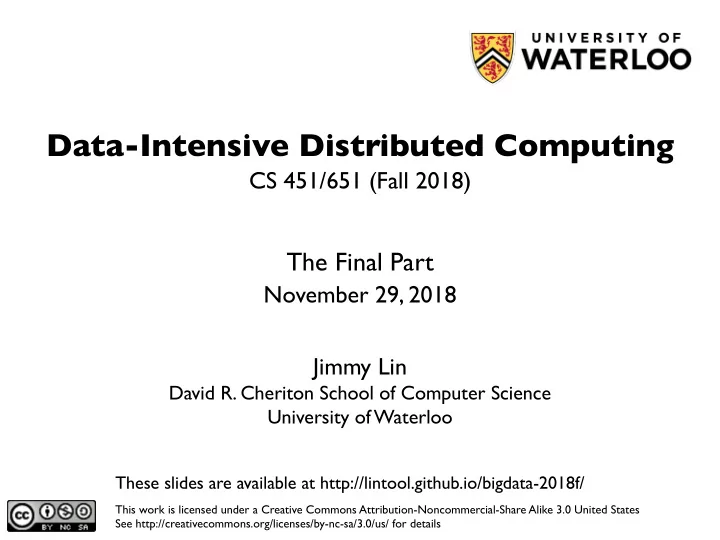

Data-Intensive Distributed Computing CS 451/651 (Fall 2018) The Final Part November 29, 2018 Jimmy Lin David R. Cheriton School of Computer Science University of Waterloo These slides are available at http://lintool.github.io/bigdata-2018f/ This work is licensed under a Creative Commons Attribution-Noncommercial-Share Alike 3.0 United States See http://creativecommons.org/licenses/by-nc-sa/3.0/us/ for details
The datacenter is the computer! “Big ideas” * Scale “out”, not “up” Limits of SMP and large shared-memory machines * Assume that components will break Engineer software around hardware failures * Move processing to the data Cluster have limited bandwidth, code is a lot smaller Process data sequentially, avoid random access Seeks are expensive, disk throughput is good
Source: NASA/JPL
Humans will colonize Mars Sooner than you think Source: https://www.newscientist.com/article/dn23542-how-to-build-a-mars-colony-that-lasts-forever/
Source: https://www.theguardian.com/science/2015/aug/27/buzz-aldrin-colonize-mars-within-25-years Source: https://twitter.com/SpaceX/status/725351354537906176 Source: http://observer.com/2016/06/elon-musk-charts-path-to-colonizing-mars-within-a-decade/
“Mars can’t just be a one-shot mission” – Buzz Aldrin “The Pilgrims on the Mayflower came here to live and stay. They didn’t wait around Plymouth Rock for the return trip, and neither will people building up a population and a settlement [on Mars].” Source: Mayflower in Plymouth Harbor by William Halsall (1882)
Needs Produce breathable air Grow food Build shelter Mine fuel and materials “Staying alive” Conduct science Connect with family and friends Engage in leisure activities Search the web “ S t a y i n g s a n e ” Maslow's hierarchy of needs
Searching the web should be as easy from Mars as it is from Marseille! The fundamental problem: Latency speed of light: 2-24 minutes rockets: 5-10 months Bandwidth is “reasonable” Lunar Laser Communications Demonstration: 622-Mbps downlink, 20-Mbps uplink SneakerNet on rockets: Easily PBs
What’s doable, what’s not?
Example: How do I grow potatoes in recycled organic waste? Source: 20 th Century Fox
Search from Mars: Implementation Step 1. Rocket SneakerNet Step 2. Beam the diffs We know exactly how to do this! Step 3. User model activate! We have a good idea how to do this! It’s a caching problem! We’ve worked out some simulations already… C. Clarke, G. Cormack, J. Lin, and A. Roegiest. Ten Blue Links on Mars. WWW 2017. J. Lin, C. Clarke, and G. Baruah. Searching from Mars. IEEE Internet Computing, 20(1):78-82, 2016.
For the truly skeptical… Search from Mars ~ Search from regions on Earth with poor connectivity Easter Island Canadian Arctic Villages in rural India More “down to Earth” applications!
Big Data Source: Wikipedia (Everest)
What’s growing faster? Big Data Moore’s Law What do I mean here? What do I mean here? Big Data > Moore’s Law Big Data < Moore’s Law Big Data ~ Moore’s Law First, a story… J. Lin. Is Big Data a Transient Problem? IEEE Internet Computing, 19(5):86-90, 2015.
What’s growing faster? Big Data Moore’s Law Let’s restrict to Human-generated data Bounds? Human population Data generation per unit time
Big Data > Moore’s Law Big Data < Moore’s Law Big Data ~ Moore’s Law Implications? Back to my story…
What’s growing faster? Big Data Moore’s Law Let’s restrict to Human-generated data What am I forgetting? Bounds? Human population Data generation per unit time
Serverless Architectures Source: Google
Server
Processor Processor Processor Processor Memory Memory Memory Memory Disk Disk Disk Disk Server Server Server Server
Processor Processor Processor Processor Memory Memory Memory Memory Disk Disk Disk Disk Persistent? (Virtualized) Server (Virtualized) Server (Virtualized) Server (Virtualized) Server Cloud (I’m going to illustrate with AWS)
Persistent Store (S3) Processor Processor Processor Processor Memory Memory Memory Memory Disk Disk Disk Disk (Virtualized) Server (Virtualized) Server (Virtualized) Server (Virtualized) Server Cloud
Persistent Store (S3) Processor Processor Processor Processor Memory Memory Memory Memory (scratch) Disk (scratch) Disk (scratch) Disk (scratch) Disk (Virtualized) Server (Virtualized) Server (Virtualized) Server (Virtualized) Server Cloud
“State” as a service (S3, RDS, SQS, …) Processor Processor Processor Processor Memory Memory Memory Memory ? (scratch) Disk (scratch) Disk (scratch) Disk (scratch) Disk (Virtualized) Server (Virtualized) Server (Virtualized) Server (Virtualized) Server Cloud
“State” as a service (S3, RDS, SQS, …) Processor Processor Processor Processor Memory Memory Memory Memory ? (Virtualized) Server (Virtualized) Server (Virtualized) Server (Virtualized) Server Cloud
“State” as a service (S3, RDS, SQS, …) Processor Processor Processor Processor Memory Memory Memory Memory Function (Virtualized) Server (Virtualized) Server (Virtualized) Server Cloud
“State” as a service (S3, RDS, SQS, …) Processor Processor Processor Processor Memory Memory Memory Memory FaaS FaaS FaaS FaaS Cloud
Serverless Architectures Doesn’t mean you don’t have servers Just that managing them is the cloud provider’s problem Write functions with well-defined entry and exit points Cloud provider handles all other aspect of execution
Source: Amazon Web Services
(Current) Serverless Architectures Asynchronous, loosely-coupled, event-driven Functions touch relatively little data What about serverless data analytics? Design goal: pure pay-as-you-go, zero costs for idle capacity Compared to current options?
Flint PySpark execution backend Intermediate Stage Input Input Input Output Output Final Stage S3 Partition Partition Partition Partition Partition Data Movement Control Flow Flint Flint Flint Flint Flint Lambda Executor Executor Executor Executor Executor Spark Context Flint Scheduler Backend Queue Queue SQS Client Amazon Web Services Youngbin Kim and Jimmy Lin. Serverless Data Analytics with Flint. IEEE Cloud 2018.
The datacenter is the computer! “Big ideas” * Scale “out”, not “up” Limits of SMP and large shared-memory machines * Assume that components will break Engineer software around hardware failures * Move processing to the data Cluster have limited bandwidth, code is a lot smaller Process data sequentially, avoid random access Seeks are expensive, disk throughput is good
Source: flickr (https://www.flickr.com/photos/39414578@N03/16042029002)
Recommend
More recommend